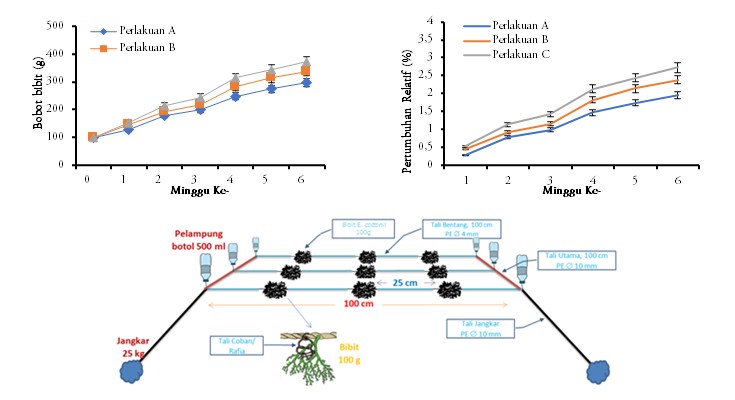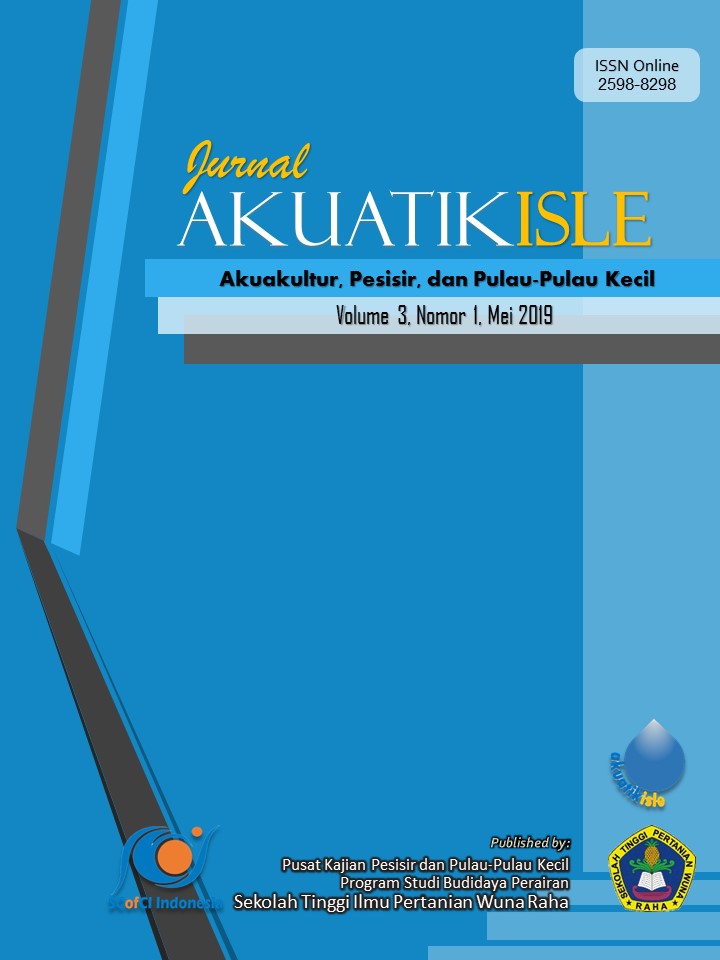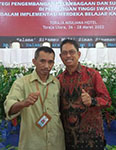Akuatikisle: Jurnal Akuakultur, Pesisir dan Pulau-Pulau Kecil
Full Length Article
The growth of seaweed (Eucheuma cottoni) at different fertilizing doses in the waters of the village of Ghonebalano, Duruka District, Muna Regency, Indonesia
Highlights
Generate NLP AI by Wizdam ID.
Abstract
The study was conducted aiming to test different fertilizer doses on the optimal growth rate of Eucheuma cottonii seaweed. The study was conducted from July to August 2016 in the waters of Ghonebalano Village, Duruka District, Muna Regency, Southeast Sulawesi. The study used NPK fertilizer with the composition of the element nitrogen (N) 15%, phosphate (P2O5) 15%, and potassium (K2O) 15%. The study used a Randomized Block Design (RBD) with 3 (three) levels of fertilizer doses and 3 (three) groups so that the number of experimental units was 9 (nine) units. While the treatments tested in the study were treatment A (without fertilizer/control), treatment B (fertilizer dose 1 g/L), and treatment C (fertilizer dose 2 g/L). The results showed that the difference in fertilizer dose significantly affected the growth rate of Eucheuma cottonii seaweed. A dosage of 2 g/L of fertilizer gives the best rate of growth of Eucheuma cottonii seaweed while the water quality at the study site shows that it is still in the optimal range for the growth of Eucheuma cottonii seaweed.
Keywords
Introduction
Section snippets
Material and Methods
Materials and methods from the full-text PDF of this article cannot be displayed.
Results
Results from the full-text PDF of this article cannot be displayed.
Discussion
Discussion from the full-text PDF of this article cannot be displayed.
Conclusions
Conclusions from the full-text PDF of this article cannot be displayed.
Acknowledgment
Acknowledgment from the full-text PDF of this article cannot be displayed.
Competing interest
The authors declare that they have no known competing financial interests or personal relationships that could have appeared to influence the work reported in this paper.
Conflict of interest
The authors declare that the research was conducted in the absence of any commercial or financial relationships that could be construed as a potential conflict of interest.
Ethical approval acknowledgements
No ethical approval required for this article. All procedures followed were in accordance with the ethical standards of the responsible committee on human experimentation (institutional and national) and with the Helsinki Declaration of 1975, as revised in 2008 (5)
Supplementary files
Data sharing not applicable to this article as no datasets were generated or analysed during the current study, and/or contains supplementary material, which is available to authorized users.
References (1)
Agustin, Anes, Aprillia Intan Saputri H., 2017. pendahuluan Rumput laut merupakan tumbuhan laut jenis alga, sejenis ganggang multi seluler golongan divisi. Inovasi teknik kimia.
Ambas I., .2006. Budidaya Rumput Laut, Pelatihan Budidaya Laut (Koremap Fase II Kab. Selayar). Makassar: Yayasan Mattirotasi.
Armita D., 2011. Analisis perbandingan kualitas air di daerah budidaya rumput laut dengan daerah tidak ada budidaya rumput laut di Dusun Malelaya, Desa Punaga, Kecamatan Mangara-bombang, Kabupaten Takalar. Universitas Hasanuddin, Makassar.
Farid A., 2008. Studi lingkungan perairan untuk budidaya rumput laut (Eucheuma cottonii) di perairan branta. Pamekasan. Madura. J. Penelitian Perikanan. 2(1):1–6.
Gaspersz V., 1991. Metode Perancangan Percobaan untuk Ilmu-ilmu Pertanian. Ilmu-ilmu Tehnik dan Biologi. Penerbit Armico. Bandung.
Harrison P.J., & Hurd C.L., 2001. Nutrient physiology of seaweeds: application of concepts to aquaculture. Cahiers de biologie marine. 42(1–2):71–82.
Kadi A., & Atmadja W.S., 1988. Rumput Laut (Algae) Jenis, Reproduksi, Produksi, Budidaya dan Pasca Panen. PPPO LIPI Jakarta.
Kordi M.G.H., & Ghufran H., 2011. Kiat sukses budidaya rumput laut di laut dan tambak. Jogjakarta: Penerbit Andi.
Kushartono E.W., Suryono S., & Setiyaningrum E., 2012. Aplikasi Perbedaan Komposisi N, P dan K pada Budidaya Eucheuma cottonii di Perairan Teluk Awur, Jepara. ILMU KELAUTAN: Indonesian Journal of Marine Sciences. 14(3):164–169.
Kusnendar E., 2002. Petunjuk Teknis Budidaya Rumput Laut Dalam Rangka Program Intensifikasi Pembudidayaan Perikanan. Direktorat Jenderal Perikanan Budidaya. Direktorat Pembudidayaan DKP. Jakarta.
Lüning K., 1990. Seaweeds: their environment, biogeography, and ecophysiology. John Wiley & Sons.
Majid A., .2018. PERTUMBUHAN RUMPUT LAUT (Eucheuma cottonii) PADA KEDALAMAN YANG BERBEDA DI TELUK EKAS, KECAMATAN JEROWARU, LOMBOK TIMUR SEAWEED GROWTH Eucheuma cottonii ON DIFFERENT DEPTHS IN EKAS BAY, JEROWARU DISTRICT, EAST LOMBOK. Universitas Mataram.
Nelson W.L., 1982. Interactions of Potassium with Moisture Temperature. IPI.
Priono B., 2016. Budidaya rumput laut dalam upaya peningkatan Industrialisasi perikanan. Media Akuakultur. 8(1):1–8.
Sedayu B.B., Basmal J., & Utomo B.S.B., 2013. Identifikasi hormon pemacu tumbuh ekstrak cairan (sap) Eucheuma cottonii. Jurnal Pascapanen dan Bioteknologi Kelautan dan Perikanan. 8(1):1–8.
Setiaji K., Santosa G.W., & Sunaryo S., 2012. Pengaruh Penambahan NPK dan UREA Pada Media Air Pemeliharaan Terhadap Pertumbuhan Rumput Laut Caulerpa racemosa var. uvifera. Journal of Marine Research. 1(2):45–50.
Soenardjo N., 2011. Aplikasi budidaya rumput laut Eucheuma cottonii (Weber van Bosse) dengan Metode Jaring Lepas Dasar (Net Bag) Model Cidaun. Buletin Oseanografi Marina. 1(1):36–44.
Sujatmiko W., & Angkasa W.I., .2003. Teknik Budidaya Rumput Laut dengan Metode Tali Panjang. Direktorat Kebijaksanaan Pengembangan&Penerapan Teknologi-BPPT. www. iptek ….
Sundari I., Ma’ruf W.F., & Dewi E.N., 2014. Pengaruh Penggunaan Bioaktivator Em4 Dan Penambahan Tepung Ikan Terhadap Spesifikasi Pupuk Organik Cair Rumput Laut Gracilaria SP. Jurnal Pengolahan dan Bioteknologi Hasil Perikanan. 3(3):88–94.
Susilowati T., Rejeki S., Zulfitriani Z., & Dewi E.N., 2012. The influence of depth of plantation to the growth rate of Eucheuma cottonii seaweed cultivated by longline method in Mlonggo beach, Jepara Regency. SAINTEK PERIKANAN: Indonesian Journal of Fisheries Science and Technology. 8(1):7–12.
Wahyu Tjahjaningsih, Anugraheny Widaratna Pratiwi M.A.A., 2019. Pengaruh Kombinasi Pupuk NPK Dan TSP Terhadap Pertumbuhan, Kadar Air Dan Klorofil A Gracilaria verrucosa. Jurnal Ilmiah Perikanan dan Kelautan. DOI: 10.20473/jipk.v1i1.11705.
Bibliographic Information
Cite this article as:
-
Submitted
29 April 2019 -
Revised
5 May 2019 -
Accepted
8 May 2019 -
Published
12 May 2019 -
Version of record
12 May 2019 -
Issue date
31 May 2019
-
Academic subject
Aquaculture; Fisheries Science
Copyright
Sangia Advertisement
Copyright © 2019 Fendi, La Lili, Abdul Rakhfid, Rochmady. Sangia Research Media and Publishing. Production and hosting by Sangia (SRM™).  This work is licensed under a Creative Commons Attribution-ShareAlike 4.0 International License.
This work is licensed under a Creative Commons Attribution-ShareAlike 4.0 International License.
Disclaimer: All claims expressed in this article are solely those of the authors and do not necessarily represent those of their affiliated organizations, or those of the publisher, the editors and the reviewers. Any product that may be evaluated in this article or claim that may be made by its manufacturer is not guaranteed or endorsed by the publisher.
Comments on this article
By submitting a comment you agree to abide by our Terms and Community Guidelines. If you find something abusive or that does not comply with our terms or guidelines please flag it as inappropriate.












